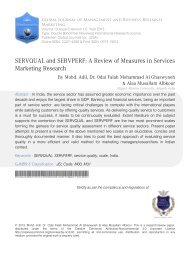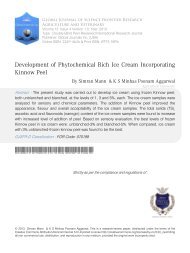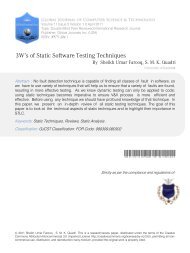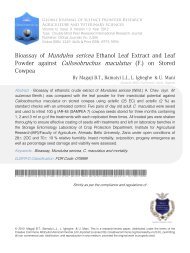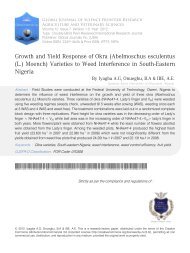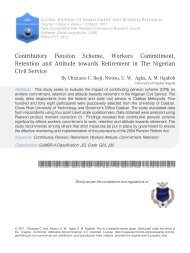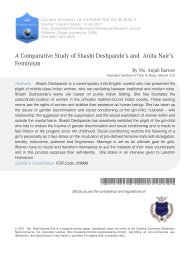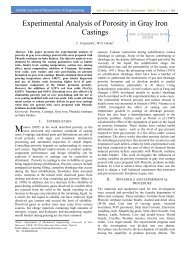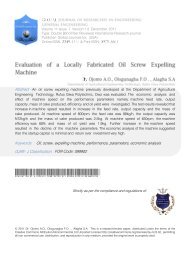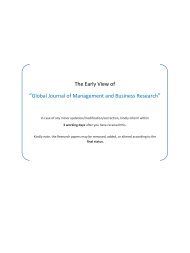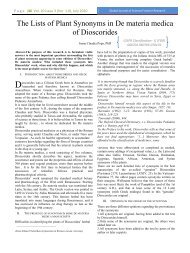Soil Colour as a Pedo-Transfer Function of Soil Organic Carbon and ...
Soil Colour as a Pedo-Transfer Function of Soil Organic Carbon and ...
Soil Colour as a Pedo-Transfer Function of Soil Organic Carbon and ...
You also want an ePaper? Increase the reach of your titles
YUMPU automatically turns print PDFs into web optimized ePapers that Google loves.
<strong>Soil</strong> <strong>Colour</strong> <strong>as</strong> a <strong>Pedo</strong>-<strong>Transfer</strong> <strong>Function</strong> <strong>of</strong> <strong>Soil</strong><br />
<strong>Organic</strong> <strong>Carbon</strong> <strong>and</strong> Fertility in a Typic<br />
Plinthaqualf<br />
Senjobi, B. A. α , Adejuyigbe, C. O. σ , Ande, O. T. ρ , Oyegoke, C.O Ѡ & Ogunkunle, A. O. ¥<br />
Abstract - The need to guide the l<strong>and</strong> users on the appropriate<br />
usage <strong>of</strong> l<strong>and</strong> <strong>and</strong> fertility maintenance is very imperative in<br />
addressing food sufficiency. Thus, a study w<strong>as</strong> conducted to<br />
investigate the erroneous belief by local farmers’ that soil<br />
colour can effectively predict soil productivity.<br />
Three l<strong>and</strong> use types namely: arable cropping (l<strong>and</strong><br />
use 1), oil palm (l<strong>and</strong> use 2), <strong>and</strong> secondary forest (l<strong>and</strong> use 3)<br />
were studied. Pr<strong>of</strong>ile pits (3 per l<strong>and</strong> use type) were dug at the<br />
three predominant l<strong>and</strong> types encountered on the site viz:<br />
crest, middle slope, <strong>and</strong> valley bottom. <strong>Soil</strong> colour (moist <strong>and</strong><br />
dry) w<strong>as</strong> determined using the munsell colour chart.<br />
The results revealed that pedons at the crest <strong>and</strong><br />
middle slope are more reddish to brownish while that <strong>of</strong> valley<br />
bottom are greyish. This changes with depth across the soil<br />
pr<strong>of</strong>iles.<br />
The hue varies with l<strong>and</strong> use type, with l<strong>and</strong> use 1<br />
having higher hue at the valley bottom than other l<strong>and</strong> use<br />
types. While this decre<strong>as</strong>es <strong>as</strong> the slope incre<strong>as</strong>es in l<strong>and</strong> use<br />
1, the reverse w<strong>as</strong> the trend in oil palm site. However, in l<strong>and</strong><br />
use 3, the hue w<strong>as</strong> generally low at the valley bottom <strong>and</strong> not<br />
<strong>as</strong> high <strong>as</strong> in l<strong>and</strong> use 1.<br />
In l<strong>and</strong> use 1, the exchangeable b<strong>as</strong>es incre<strong>as</strong>e <strong>as</strong><br />
the hue 10YR – 25YR decre<strong>as</strong>es in the surface soils except for<br />
valley bottom soils, where the reverse is the trend.<br />
<strong>Organic</strong> carbon <strong>and</strong> exchangeable acidity incre<strong>as</strong>es<br />
with decre<strong>as</strong>e in hue irrespective <strong>of</strong> the l<strong>and</strong> type in l<strong>and</strong> use<br />
1. However, phosphorous value decre<strong>as</strong>es <strong>as</strong> the hue<br />
decre<strong>as</strong>es in all the l<strong>and</strong> types, while Zn is constant.<br />
At l<strong>and</strong> use 2, the exchangeable b<strong>as</strong>es except for<br />
calcium follow the reverse trend <strong>as</strong> in l<strong>and</strong> use 1. While<br />
organic carbon incre<strong>as</strong>es in l<strong>and</strong> use 1, the reverse is the<br />
trend in the l<strong>and</strong> use 2, with nitrogen following the same<br />
sequence <strong>as</strong> organic carbon.<br />
Exchangeable acidity, phosphorous <strong>and</strong> Zinc only<br />
decre<strong>as</strong>es with decre<strong>as</strong>ing soil hue in valley bottom soils, <strong>and</strong><br />
incre<strong>as</strong>es in the other l<strong>and</strong> types.<br />
At l<strong>and</strong> use 3, only sodium <strong>and</strong> pot<strong>as</strong>sium incre<strong>as</strong>e<br />
with decre<strong>as</strong>ing hue (7.5YR – 25YR) at the crest <strong>and</strong> middle<br />
slope sections, while at valley bottom soils the reverse is the<br />
trend.<br />
While magnesium incre<strong>as</strong>es with decre<strong>as</strong>ing soil hue<br />
across the l<strong>and</strong> types, organic carbon, calcium, zinc <strong>and</strong><br />
copper decre<strong>as</strong>es with decre<strong>as</strong>ing soil hue. Nitrogen,<br />
phosphorous <strong>and</strong> pH KCl <strong>as</strong> well <strong>as</strong> exchangeable acidity<br />
follow the same sequence with sodium <strong>and</strong> pot<strong>as</strong>sium in l<strong>and</strong><br />
use 3.<br />
Author α σ : Federal University <strong>of</strong> Agriculture, Abeokuta, Ogun State,<br />
Nigeria. E-mail : bol<strong>as</strong>enjobi @ gmail.com<br />
Author ρ ¥ : Institute <strong>of</strong> Agriculture <strong>and</strong> Research Training, Moor<br />
Plantation, Ibadan, Nigeria.<br />
Author Ѡ : University <strong>of</strong> Ibadan, Ibadan, Nigeria.<br />
It w<strong>as</strong> obvious from the study that soil colour is not a<br />
sufficient parameter in <strong>as</strong>certaining soil fertility status.<br />
Therefore, l<strong>and</strong> use analysis remains the vital tool in <strong>as</strong>sessing<br />
fertility status <strong>of</strong> the soil before optimal <strong>and</strong> sustainable<br />
production can be attained.<br />
Keywords : soil colour, pedo - transfer, organic carbon,<br />
fertility, typic plinthaqualf.<br />
I. Introduction<br />
The general erroneous concept <strong>of</strong> soil fertility status<br />
by pe<strong>as</strong>ant farmers through the colour <strong>of</strong> the soil<br />
calls for urgent investigation especially at this era<br />
<strong>of</strong> soil pollution. This is because sewage sludge <strong>and</strong> to<br />
some extent heavy metals such <strong>as</strong> lead (Pb) also<br />
constitute to the colour <strong>of</strong> the soil. Anthropogenic<br />
activities <strong>as</strong> well <strong>as</strong> fluctuating water level also play<br />
major role in the colour <strong>of</strong> the soil (Majlis, 1967).<br />
Farmers generally believe that dark colour is<br />
synonymous to fertile loamy soil. They tend to attribute<br />
fertility with colour without <strong>as</strong>certaining the physical <strong>and</strong><br />
chemical properties <strong>of</strong> the soil. <strong>Colour</strong> reflects an<br />
integration <strong>of</strong> chemical, biological <strong>and</strong> physical<br />
transformations <strong>and</strong> translocations that have occurred<br />
within a soil (Scheonberger et al., 2002).<br />
The colour <strong>of</strong> the soil is usually determined by<br />
the nature <strong>of</strong> the fine material. Generally, the colour <strong>of</strong><br />
the soil is determined by the quantity <strong>and</strong> state <strong>of</strong> the<br />
iron <strong>and</strong>/or the organic matter. Hematite (Fe 2 O 3 ) for<br />
example is responsible for the red colour in many soils<br />
developed under strongly aerobic conditions in tropical<br />
<strong>and</strong> sub-tropical are<strong>as</strong> (Majlis, 1967). However, the<br />
mineral responsible for most <strong>of</strong> the inorganic colouration<br />
in aerobic soils is goethite (Fe O-OH), with colours<br />
ranging from reddish – brown to yellow <strong>as</strong> it’s hydration<br />
incre<strong>as</strong>es.<br />
Many grey, olive <strong>and</strong> blue colours occur in the<br />
soils <strong>of</strong> partially or completely anaerobic situations <strong>and</strong><br />
originate from the presence <strong>of</strong> iron in the reduced or<br />
ferrous state. Sometimes, substances with blue colour<br />
such <strong>as</strong> vivianite may form under these conditions <strong>and</strong><br />
therefore contribute to the colouration (Ojo-Atere et al.,<br />
2009).<br />
The colour <strong>of</strong> the upper horizons usually<br />
changes from brown to dark brown to black, <strong>as</strong> the<br />
organic matter content incre<strong>as</strong>es, <strong>and</strong> there is a<br />
tendency for the organic matter to become darker in<br />
2013<br />
XII Issue I V ersion I Year<br />
31<br />
Global Journal <strong>of</strong> Science Frontier Research ( H ) Volume XIII<br />
© 2013 Global Journals Inc. (US)



